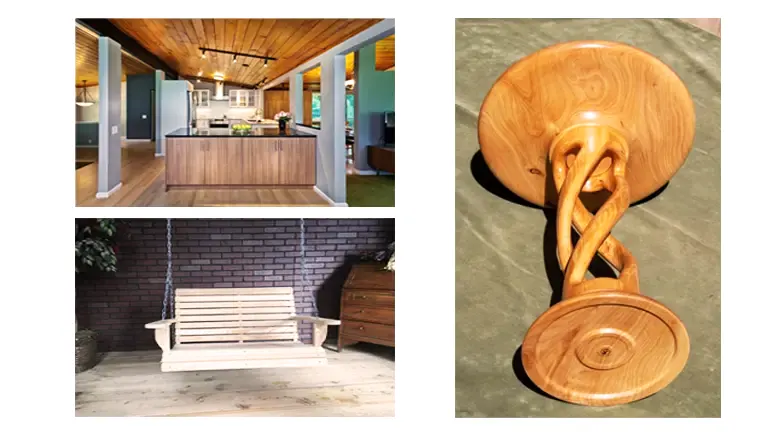Arizona Cypress Lumber
- June 27, 2023
- 0 comment

The Arizona Cypress (Cupressus arizonica) is a unique type of softwood originating from the southwestern regions of the United States and northern Mexico. Unlike common timber trees, the Arizona Cypress isn’t typically used on a large scale due to its relatively smaller size and regional growth. However, its distinctive properties make it a suitable choice for certain niche applications.
Aesthetically, the Arizona Cypress offers an appealing light, yellowish-brown color in its heartwood, which occasionally sports a hint of gray. The sapwood displays a paler yellow shade, often seamlessly blending with the heartwood. This softwood is also known for its tight, straight grain patterns and smooth texture, resulting in an evenly pleasing appearance that’s appreciated in woodworking projects.
In terms of usability, the Arizona Cypress is fairly workable with both hand and machine tools, although knots and growth defects can pose some challenges. However, it responds well to various finishing techniques, such as gluing, staining, and finishing. Its moderate durability against decay makes it a practical choice for custom projects, fence posts, and even fuel. More extensive uses include casket manufacturing, attesting to its unique versatility. For anyone considering using this wood, it’s always a good idea to confirm specific details from a trustworthy local source or supplier due to the limited commercial usage of the Arizona Cypress.
| Property | Value |
|---|---|
| Common Name(s) | Arizona Cypress |
| Scientific Name | Cupressus arizonica |
| Distribution | Southwestern United States, Mexico |
| Tree Size | 40-60 ft (12-18 m) |
| Average Dried Weight | 29-37 lbs/ft3 (465-595 kg/m3) |
| Specific Gravity | 0.46-0.59 |
| Janka Hardness | 1,060-1,460 lbf (4,710-6,490 N) |
| Modulus of Rupture | 10,100-13,500 psi (69.6-93.1 MPa) |
| Elastic Modulus | 1,290,000-1,630,000 psi (8.90-11.24 GPa) |
| Crushing Strength | 5,070-6,630 psi (35.0-45.8 MPa) |
| Shrinkage | Radial: 4.8%, Tangential: 8.6%, Volumetric: 14.5% |
Color/Appearance:
Arizona Cypress lumber ranges in color from light yellowish-brown to reddish-brown. It can exhibit knots and streaks of darker brown or reddish hues. Over time, the wood tends to darken and develop a rich patina.

Grain/Texture:
The grain of Arizona Cypress is generally straight, with a fine to medium texture. The wood has a uniform and smooth appearance, with occasional knots and irregularities that add character to the grain pattern.
Rot Resistance
Arizona Cypress is known for its natural resistance to rot, decay, and insect infestation. The wood’s inherent durability makes it suitable for outdoor applications where exposure to moisture is a concern.
Workability:
Arizona Cypress is relatively easy to work with both hand and machine tools. It cuts cleanly, and it has good gluing and finishing properties. The wood can be nailed, screwed, and sanded with ease, resulting in smooth and precise finishes.
Odor
Arizona Cypress has a distinctive aromatic scent, emitting a pleasant and sweet fragrance. This aroma can be enjoyed during woodworking projects and may persist in finished products.
Allergies/Toxicity
There are no known specific allergenic or toxic properties associated with Arizona Cypress lumber. However, as with any wood, individuals with existing allergies should take precautions and wear appropriate protective equipment when working with this material.
Pricing/Availability
Arizona Cypress lumber is typically available at a moderate price range. Its availability may vary depending on the region and local suppliers. It is advisable to check with local lumberyards or specialized wood suppliers for availability and current pricing.
Sustainability
Arizona Cypress is considered a sustainable choice for lumber, as it is abundant in its native range. Responsible forest management practices ensure the preservation of the species and a continuous supply of this versatile wood.
Common Uses
Arizona Cypress lumber finds applications in various woodworking projects. It is commonly used for exterior siding, decking, fences, outdoor furniture, and other outdoor structures. It’s natural rot resistance and attractive appearance make it a popular choice for outdoor applications.

Frequently Asked Questions:
- Is Arizona Cypress suitable for indoor applications? While Arizona Cypress is primarily used for outdoor projects due to its rot resistance, it can also be utilized for indoor applications such as paneling, flooring, and furniture.
- Does Arizona Cypress require finishing or treatment? Arizona Cypress does not require additional finishing or treatment for outdoor use. However, applying a protective finish can enhance its appearance and further prolong its lifespan.
- Can Arizona Cypress be stained or painted? Yes, Arizona Cypress can be stained or painted to achieve desired colors and finishes. However, it is advisable to conduct test samples to ensure desired results.
- How does Arizona Cypress handle humid environments? Arizona Cypress performs well in humid environments due to its natural resistance to moisture and decay. It is a suitable choice for regions with high humidity.
- Is Arizona Cypress suitable for carving or intricate woodworking projects? Yes, Arizona Cypress is known for its workability and can be used for carving, turning, and intricate woodworking projects. Its straight grain and fine texture allow for detailed and precise work.














Leave your comment